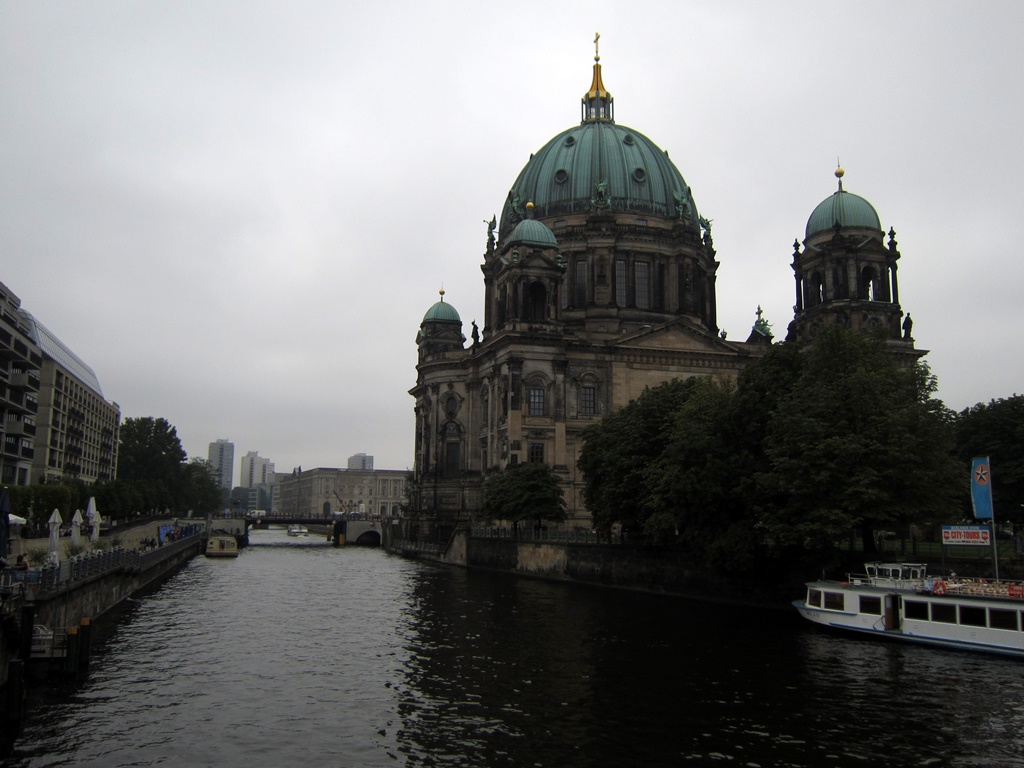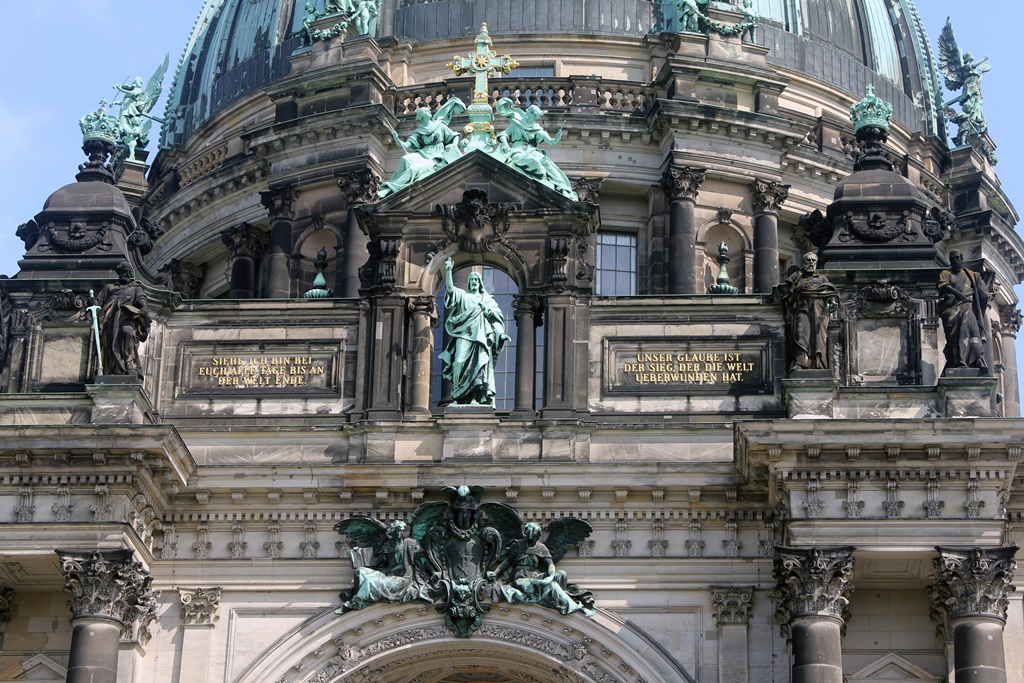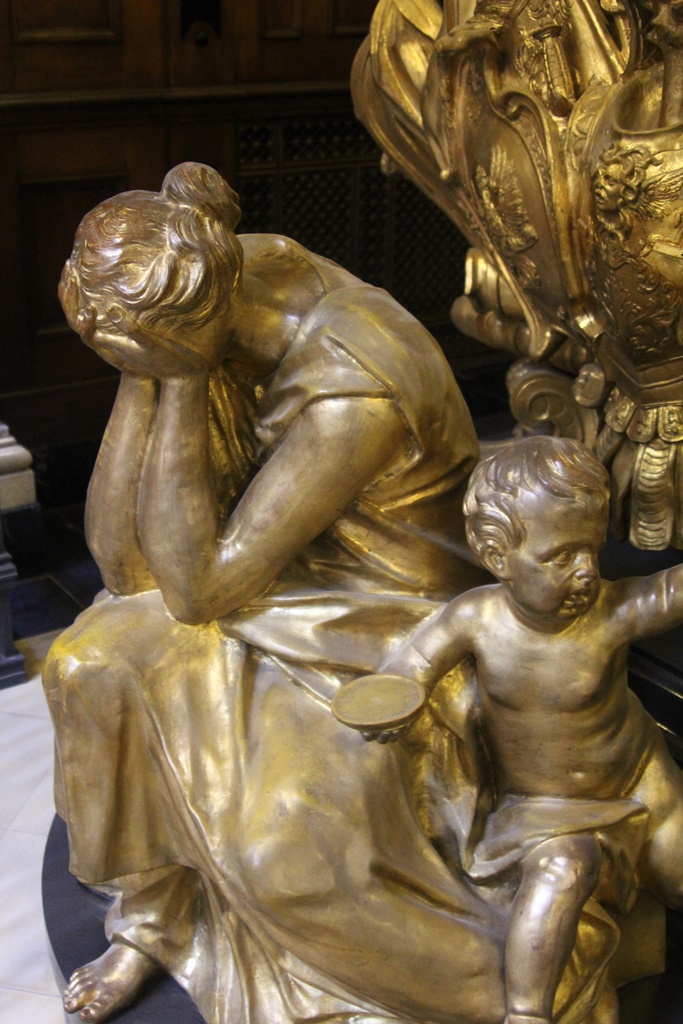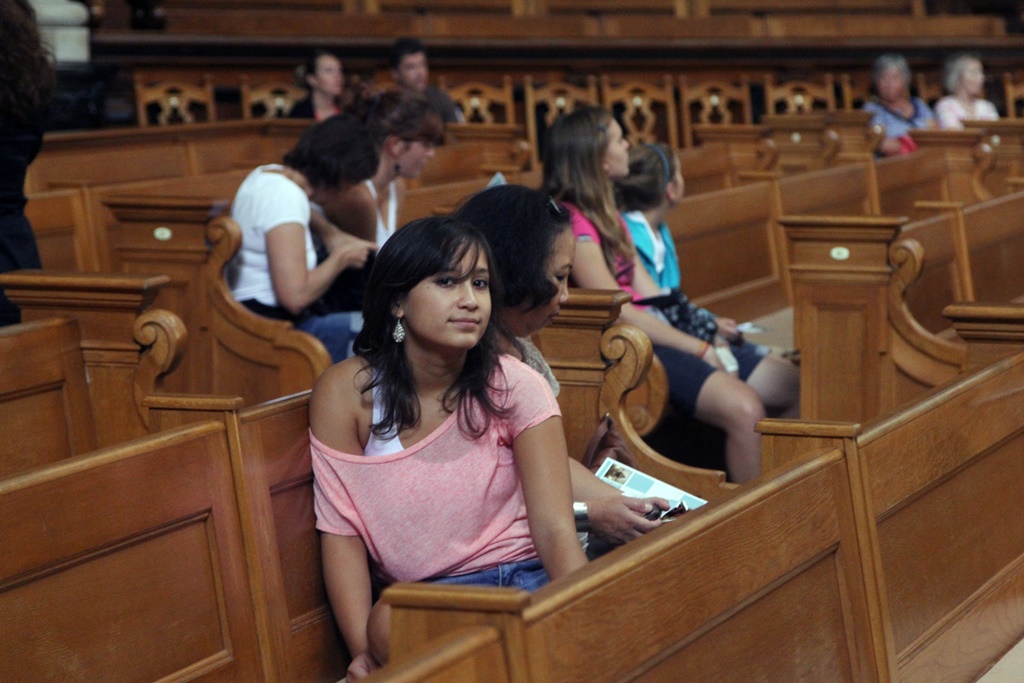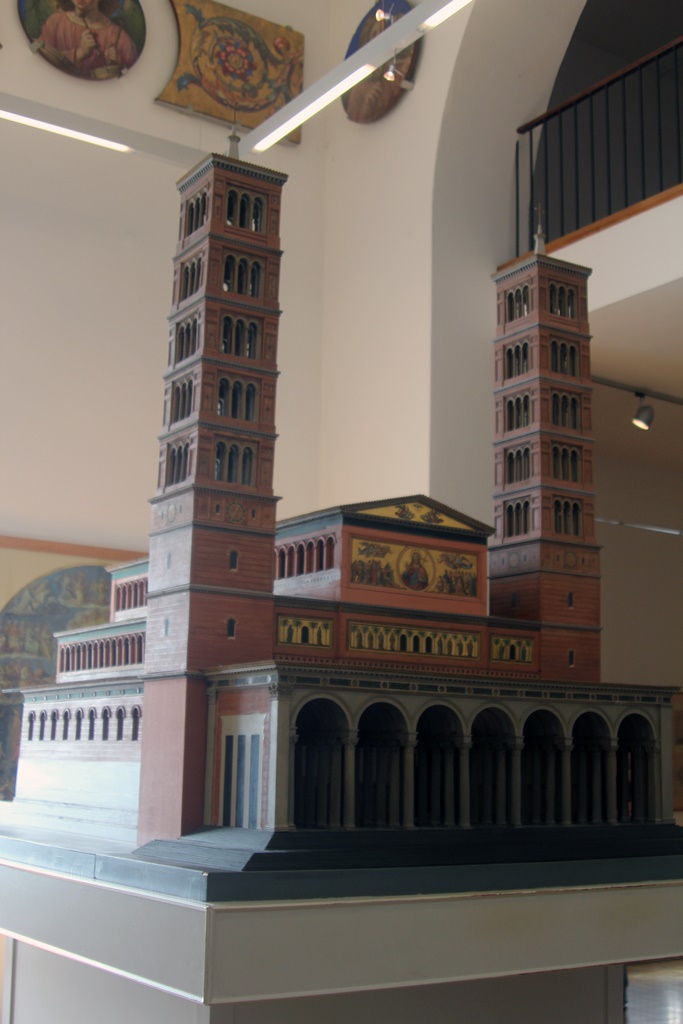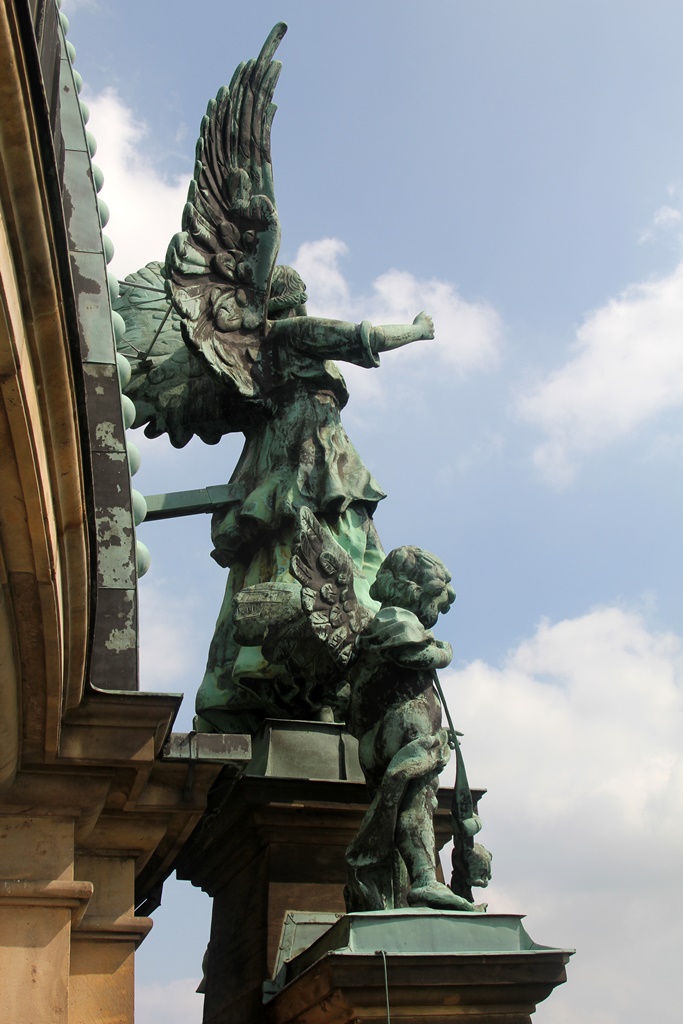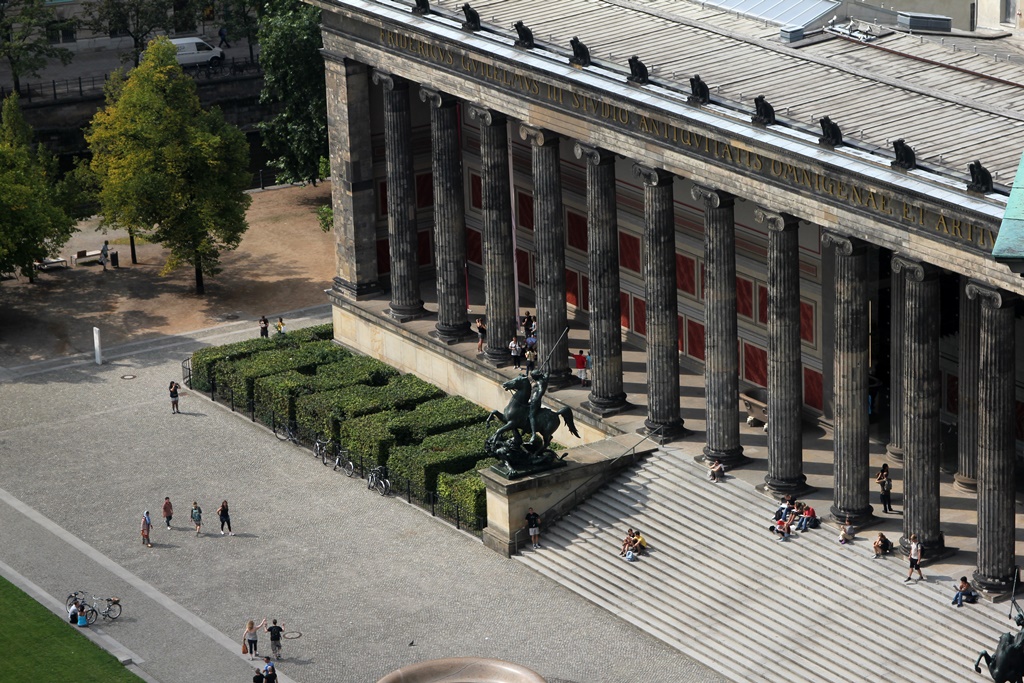Berliner Dom and Spree River
The Berliner Dom,
or Berlin Cathedral, while the largest church in the city, isn’t
technically a cathedral at all, as it’s not the home base of a bishop. The official name
of the church (or rather its English equivalent) is "Evangelical Supreme Parish and
Collegiate Church". The church is not Catholic (Berlin’s Catholic cathedral is the
nearby St. Hedwig’s), and the local Evangelical bishop’s base is split between two other
churches (one in East Berlin and one in West Berlin). A church has served the Berliner
Dom’s community, at or near the location of the present building, since 1451. The present
building was inaugurated in 1905.
To get to the Berliner Dom from the Neues Museum, we took a somewhat indirect route. Instead
of going south around the eastern end of the Altes Museum, we headed west, crossing a bridge
across the Kupfergraben (the name given to the short western branch of the Spree River
that makes the Museumsinsel an island), after which we followed the Kupfergraben south to the
next bridge, which we used to cross back to the island.
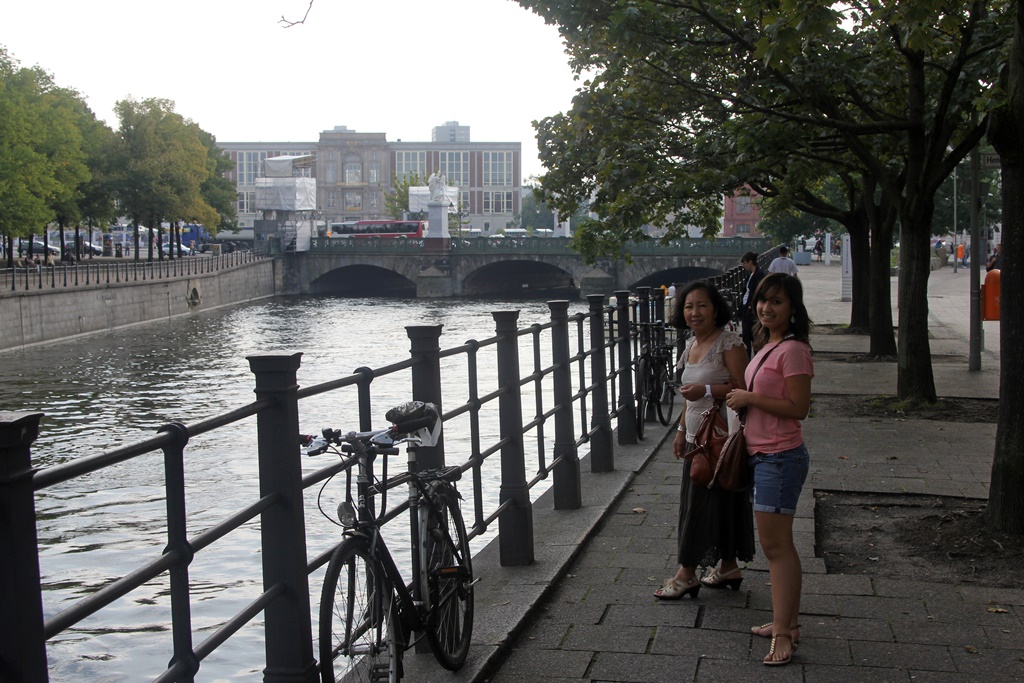
Nella and Connie with Kupfergraben
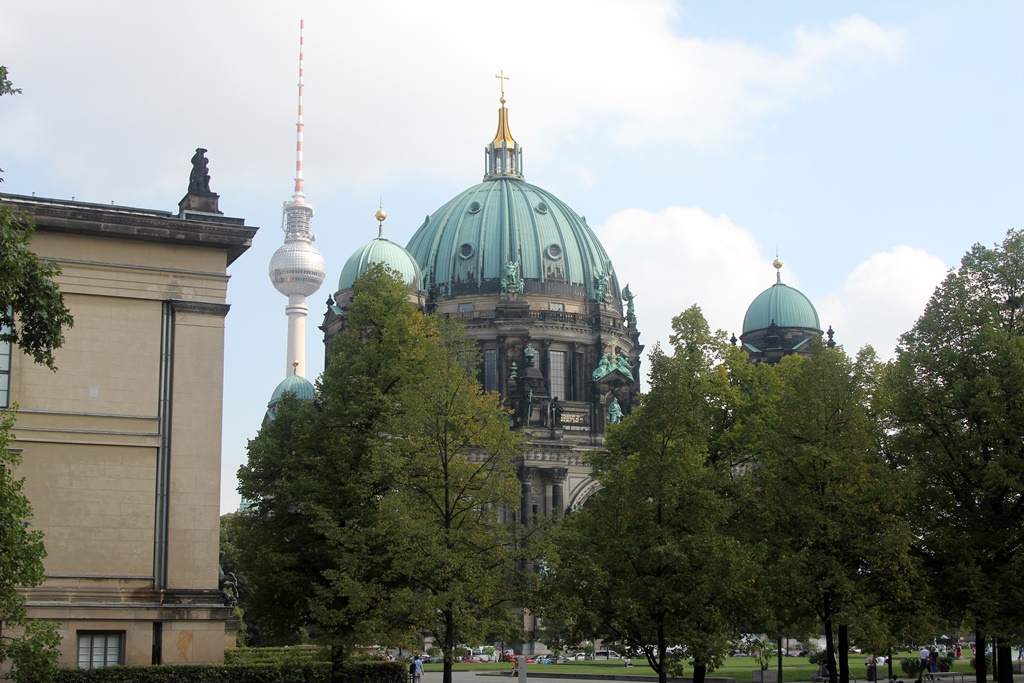
Berliner Dom and Fernsehturm
At this point we found ourselves slightly south of the Berliner Dom, and on
the opposite side of a large grassy area with a fountain in the middle of it.
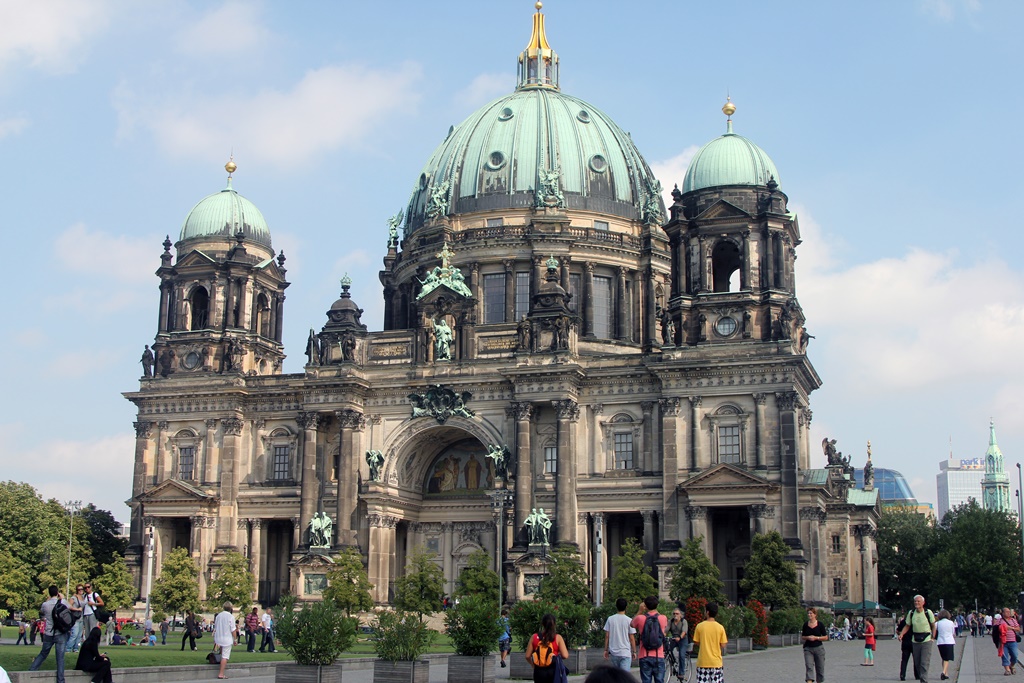
Berliner Dom
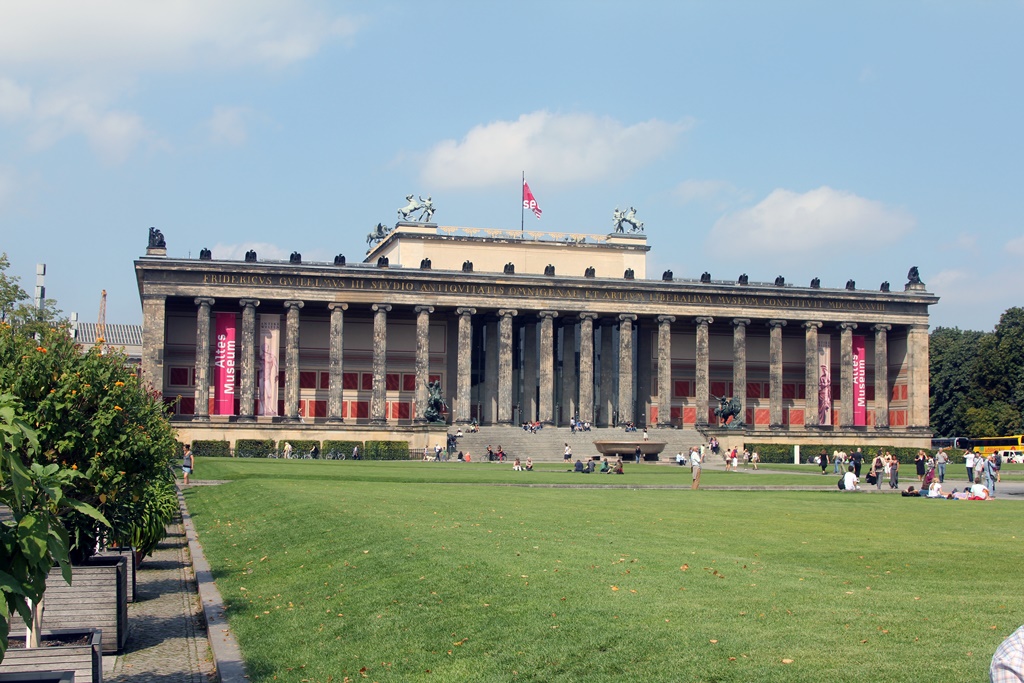
Altes Museum and Lustgarten
The grassy area has a history of its own. It’s called the Lustgarten, or
pleasure garden, reflecting its principal use since its establishment in the 16th
Century. It was first set aside as an area for a kitchen garden for a palace to
the south that was known as the Stadtschloss, or city palace (first built in
the 15th Century, much damaged during World War II and eventually demolished by the
East Germans in 1950). In the 17th Century it became a landscaped public park, but
for most of the 18th Century it was turned into a training ground for an increasingly
militaristic Prussia. At the end of the 18th Century it again became a park, and
over the next century became a home for sculptures and a technically-advanced
fountain. A museum (the present-day Altes Museum) was completed on its northern
boundary in 1830. A Protestant church occupied the eastern boundary for most of the
19th Century, but it was demolished and replaced with the present Berliner Dom
between 1894 and 1905. After World War I, political rallies of various persuasions
were held here. After the Nazis came into power, the garden and sculptures were
removed and paved over, and the area became a parade ground where gigantic, frenzied
crowds could listen to orations by Adolf Hitler or his propaganda minister Joseph
Goebbels. By the end of the war the parade ground had become a cratered wasteland. The
East Germans repaired the bomb damage and planted some trees around the perimeter of
the paved area, and renamed the area "Marx-Engels-Platz". Following reunification,
landscaping was reintroduced (to a point – it seems to consist of seven nicely mown and
edged patches of lawn, divided by concrete pathways), a modern fountain was placed in
the middle, and the area regained its former name, Lustgarten.
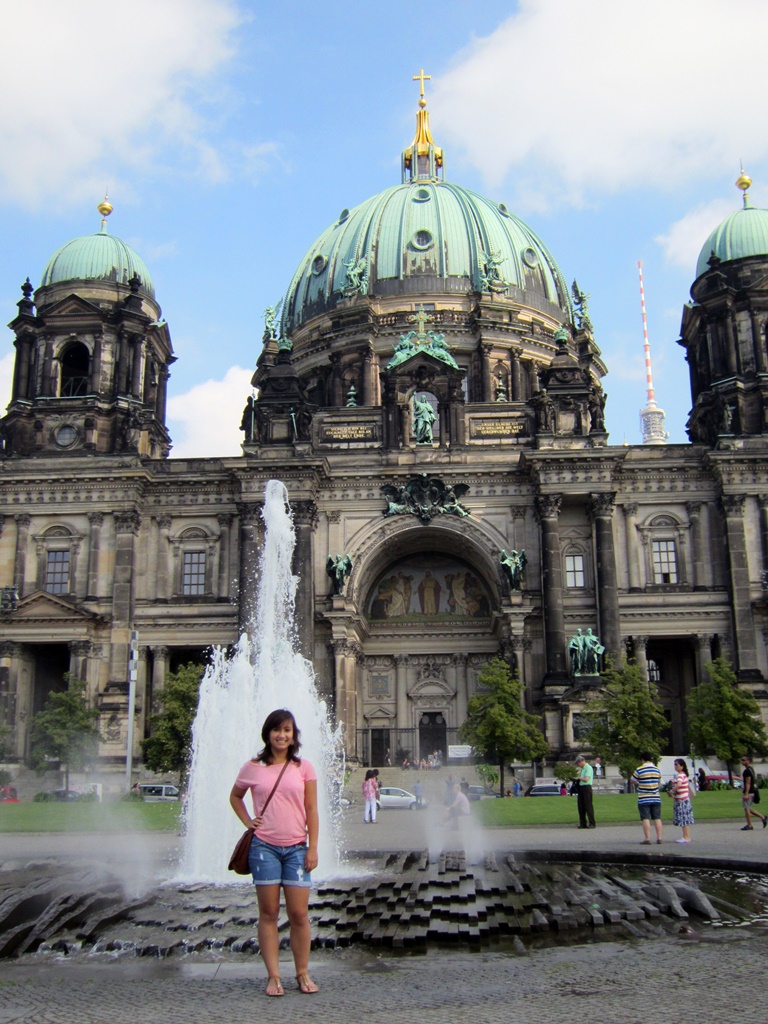
Connie, Fountain and Berliner Dom

Nella and Connie with Fountain, Altes Museum and Church
We lingered by the fountain for a little bit, catching our breath after our
exploration of the Neues Museum, and then headed for the entrance to the Berliner
Dom.
Church Façade
Most of the inside of the church appears to be in very good condition. This is because
much of it is new. In 1944 an Allied firebomb hit the lantern on top of the main dome,
which burned and eventually collapsed through the dome onto the floor, causing extensive
damage to the church and to the crypt beneath the floor, which held tombs of the
Prussian/German Hohenzollern dynasty. From 1949-53 a temporary roof was built to plug
up the big hole. In the 1960’s a serious effort was begun to prepare for reconstruction
of the church. This was not discouraged by the East German authorities, as they needed
the money. Work began in 1975, first on the outside of the church (with ornamentation
somewhat scaled back from what had been there previously) and then on the inside, and
the church was reopened in 1993, an event televised throughout Germany. Work continued
on the stained glass and the dome mosaics, which were fully restored by 2002. Restoration
of the crypt is still ongoing, though most of it is open to visitors. We didn’t visit the
crypt.
The main church had plenty to look at, though. The dome and the altar were
impressive. The stained glass windows behind the altar were different from those usually
seen in churches – instead of being mosaics of colored pieces of glass, they had the
appearance of glass panes with paintings on them. To the left of the altar is a large
pipe organ, a survivor from 1905. Statues of Martin Luther and John Calvin are reminders
that this is a Protestant church.
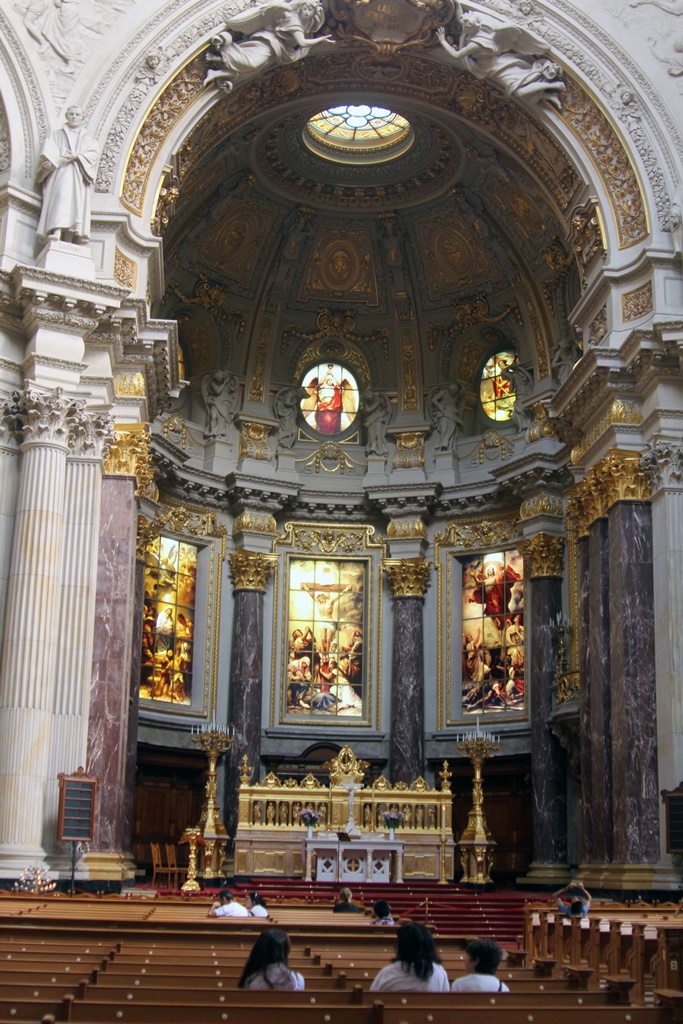
Apse
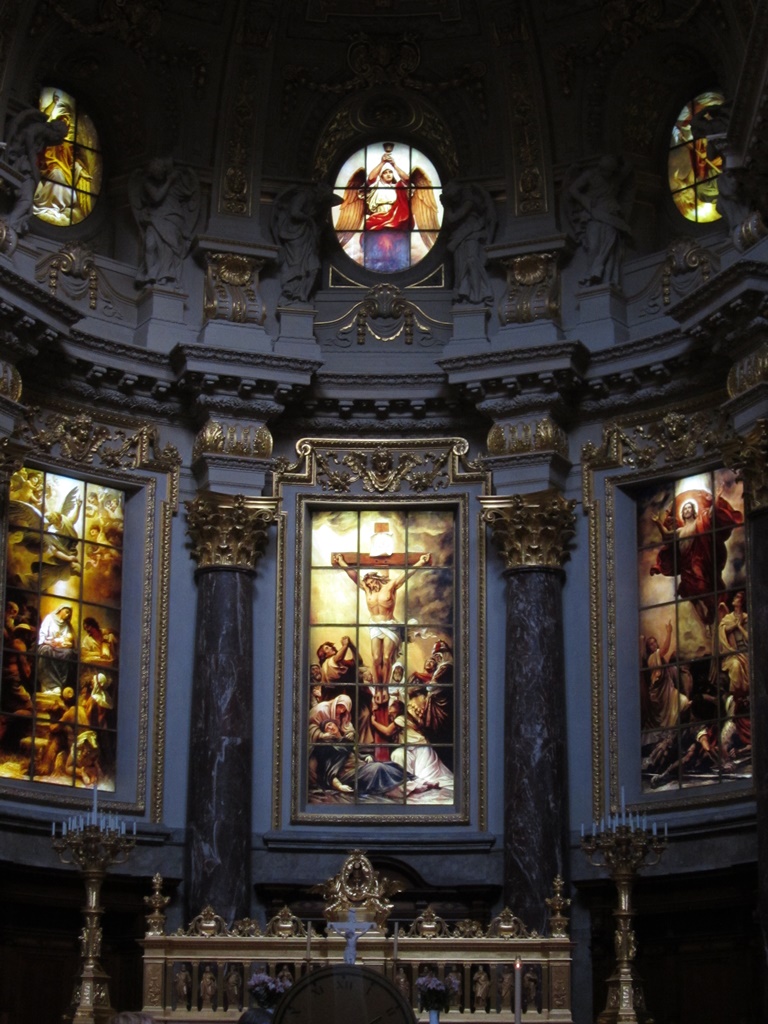
Stained Glass
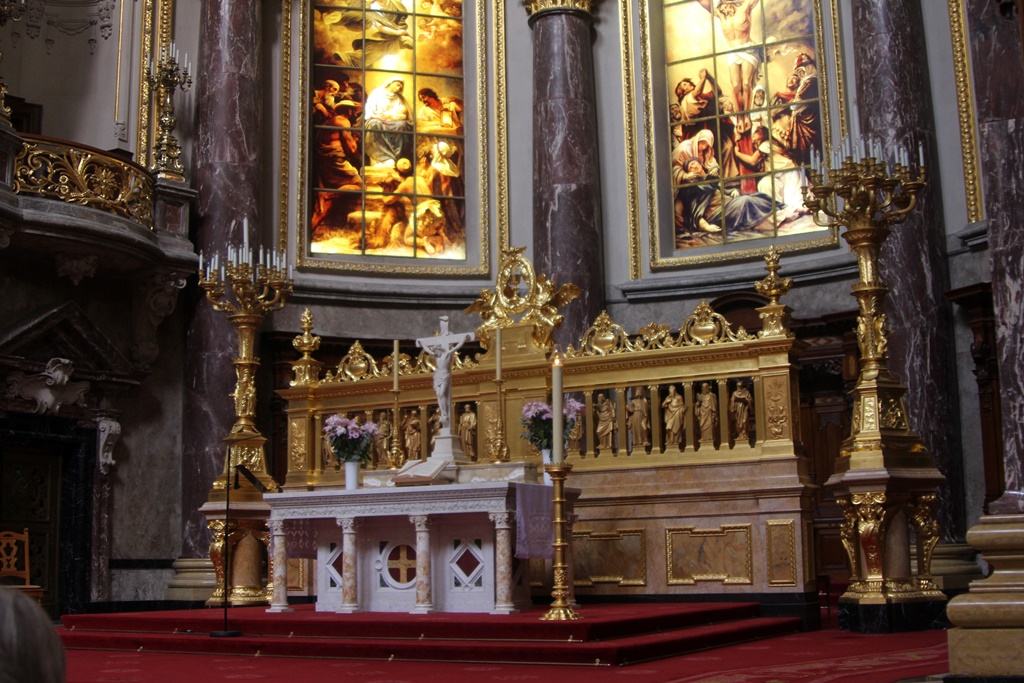
Main Altar

Pulpit, Organ and Main Dome
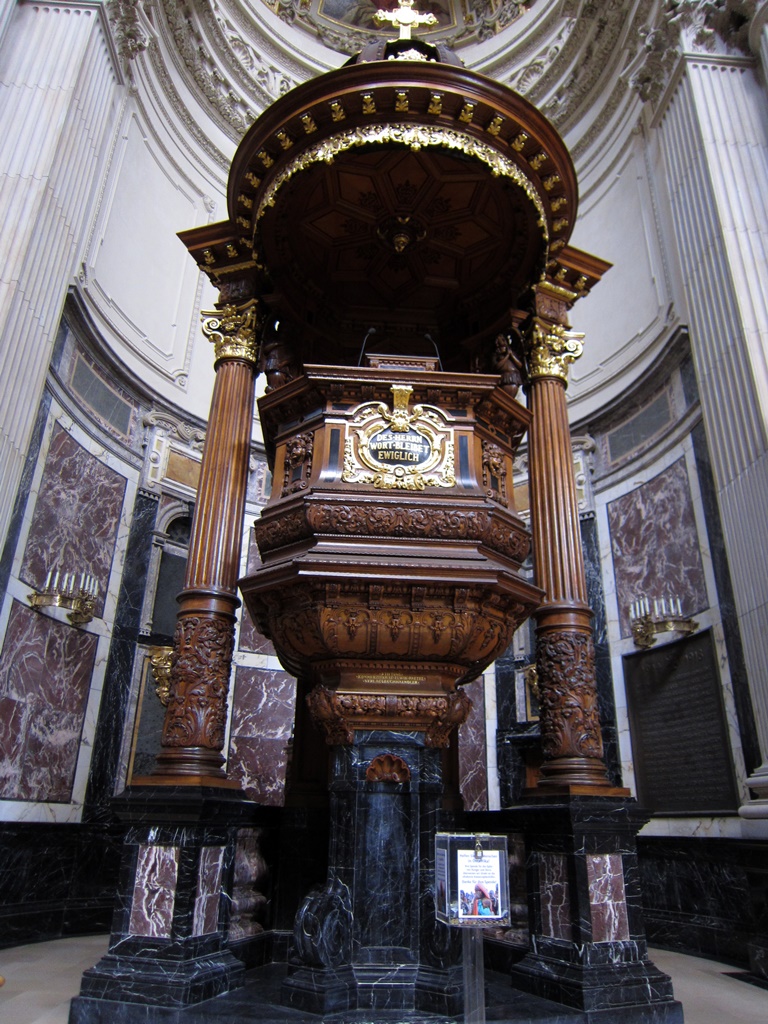
Pulpit
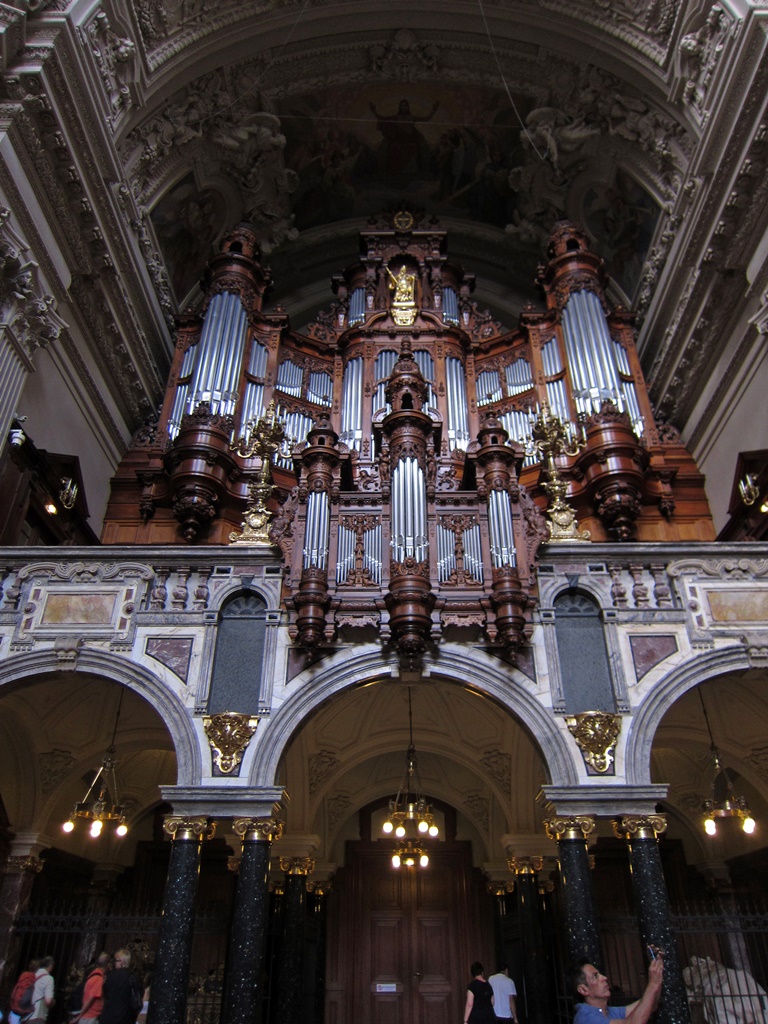
Organ
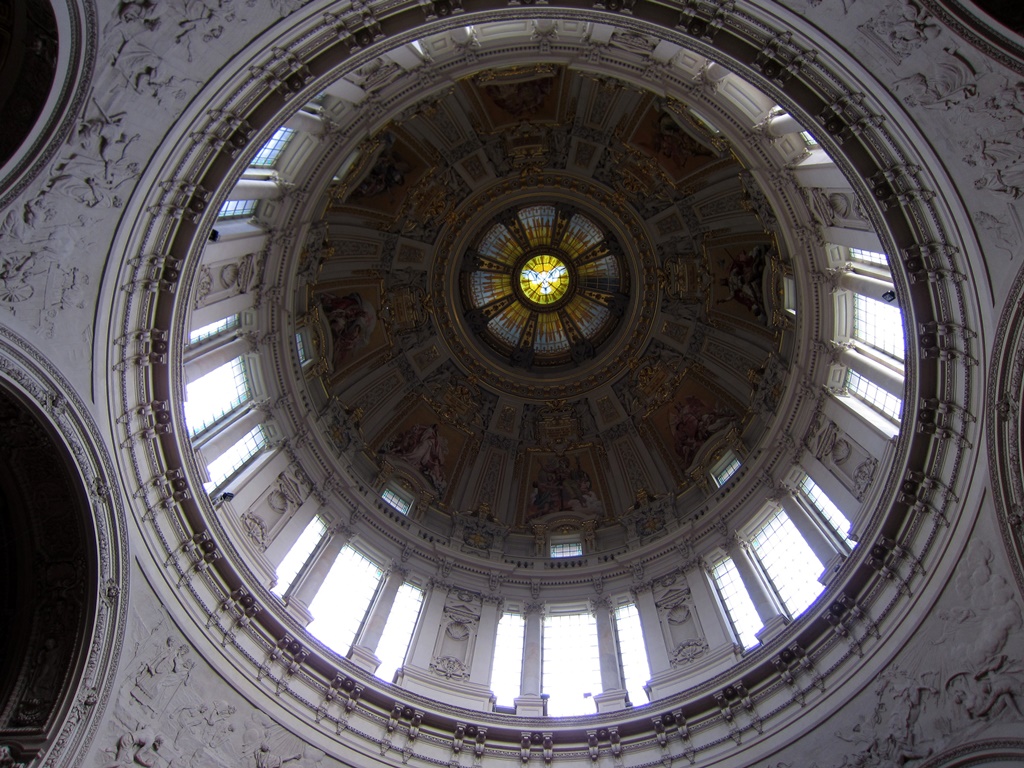
Main Dome
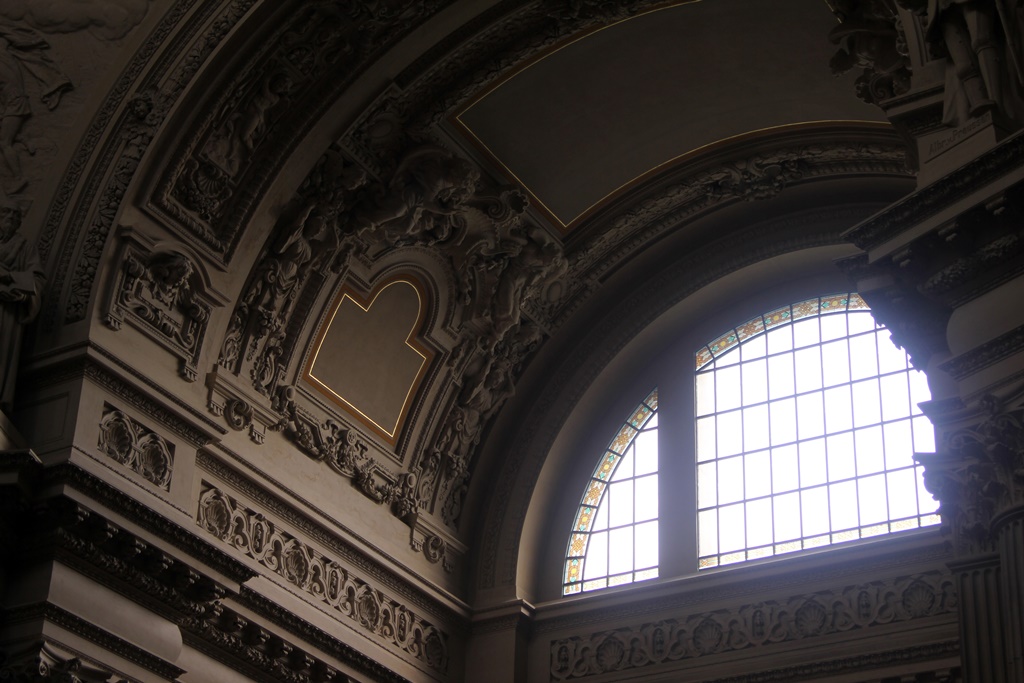
Window and Arch
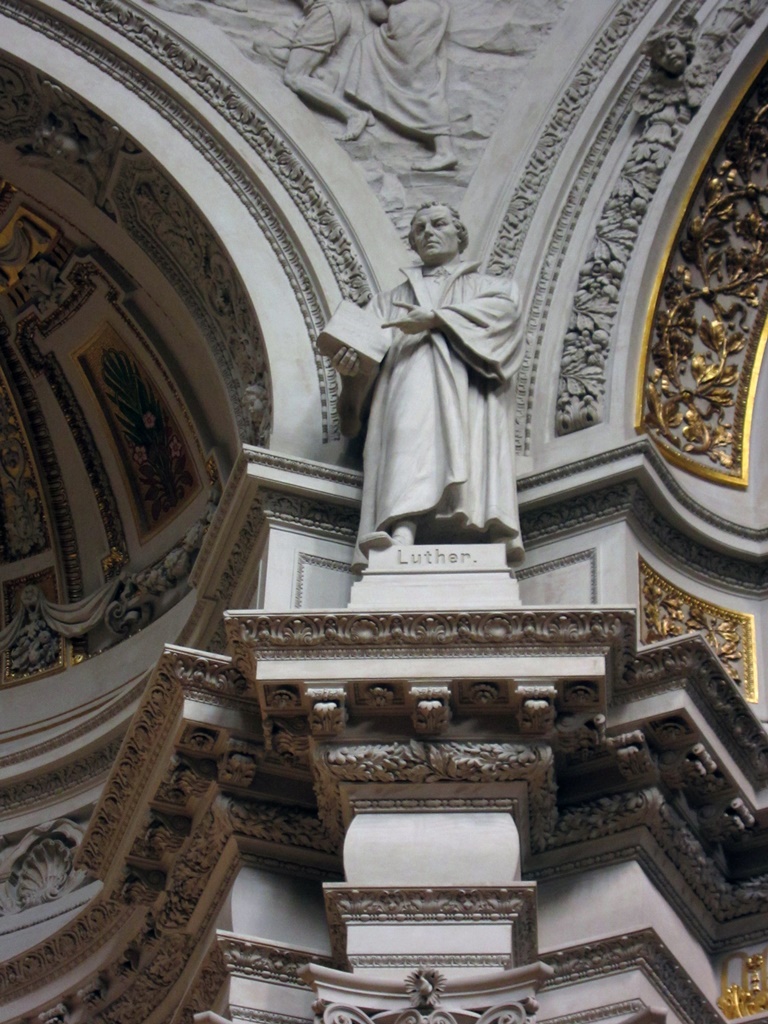
Statue of Martin Luther
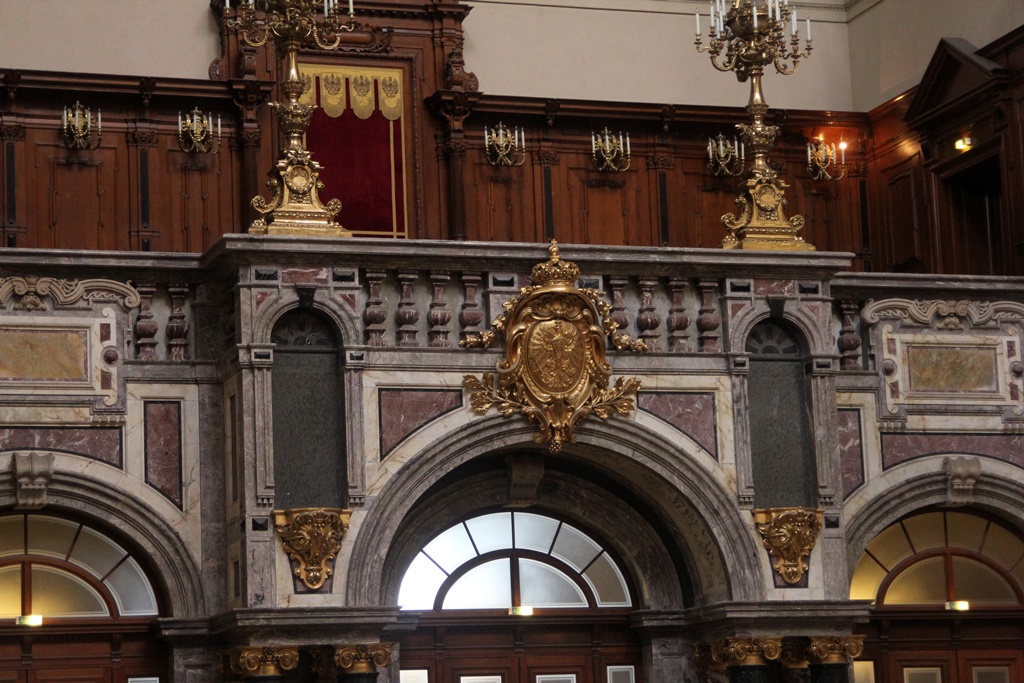
Imperial Balcony
Across from the organ, to the right of the altar, are the tombs of the first
Prussian king, Frederick I (1657-1713), and his wife Sophie Charlotte (1668-1705).
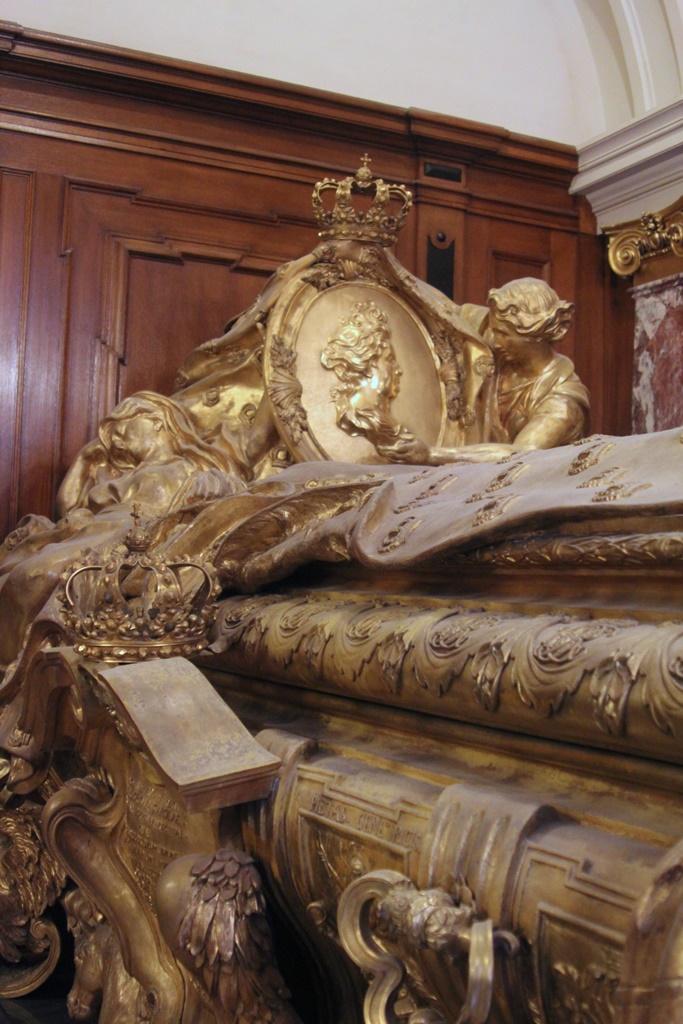
Tomb of Sophie Charlotte
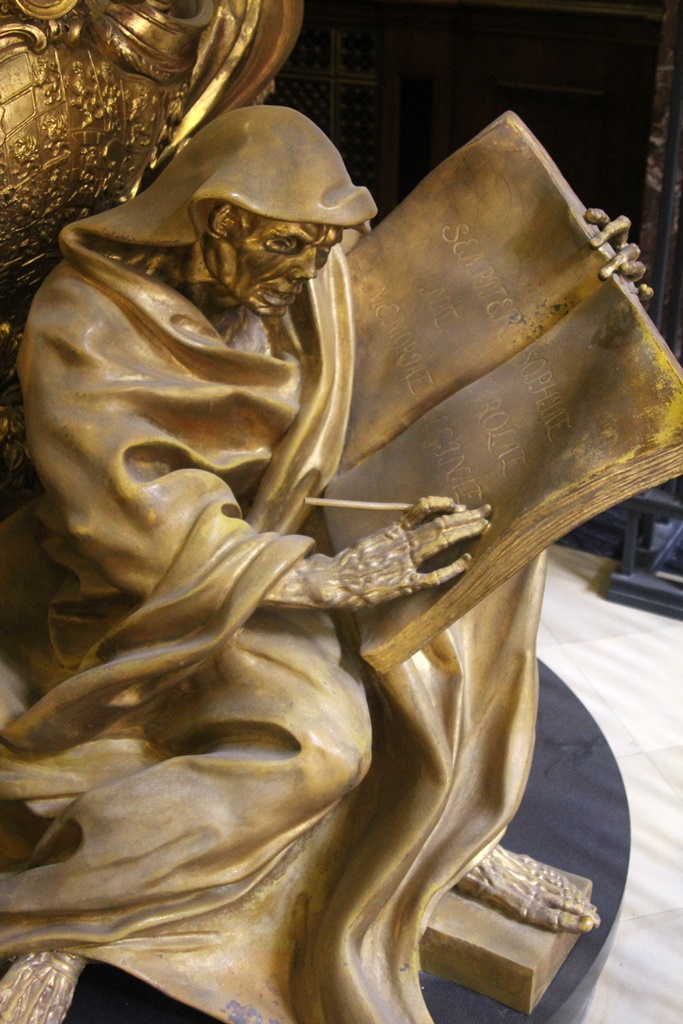
Detail, Tomb of Sophie Charlotte
Detail, Tomb of Frederick I
While Nella rested on a pew, Connie and I went upstairs to see a small museum, passing the
church’s Imperial Staircase on the way.
Connie and Nella Amongst the Pews
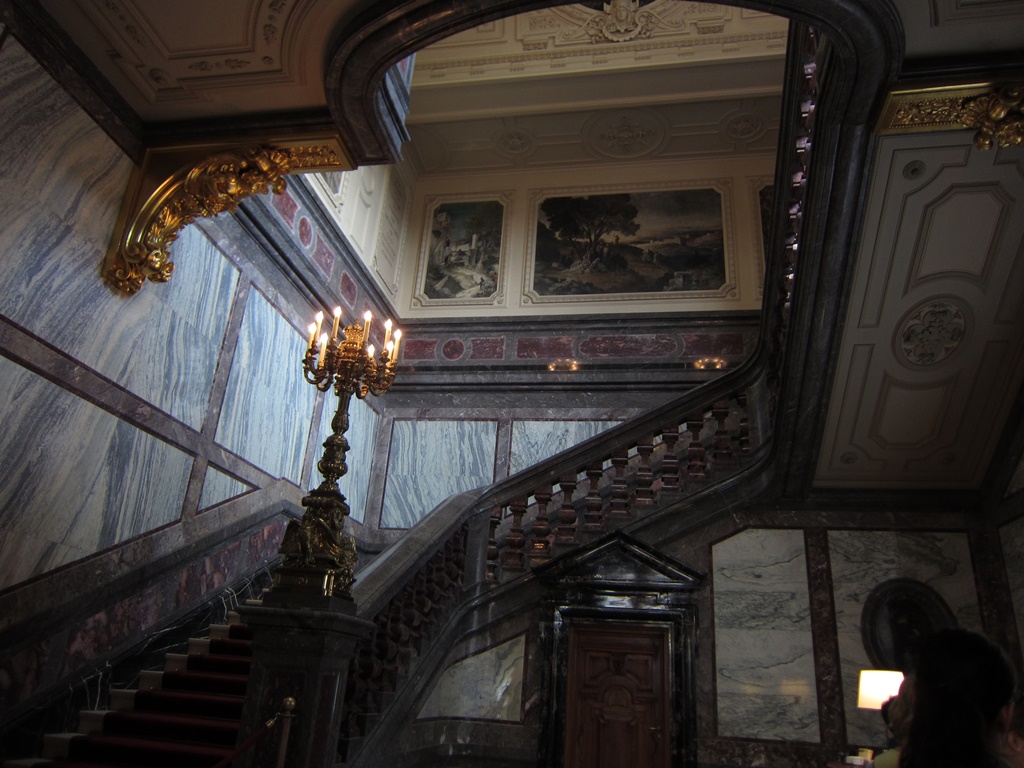
Imperial Staircase, Ground Level
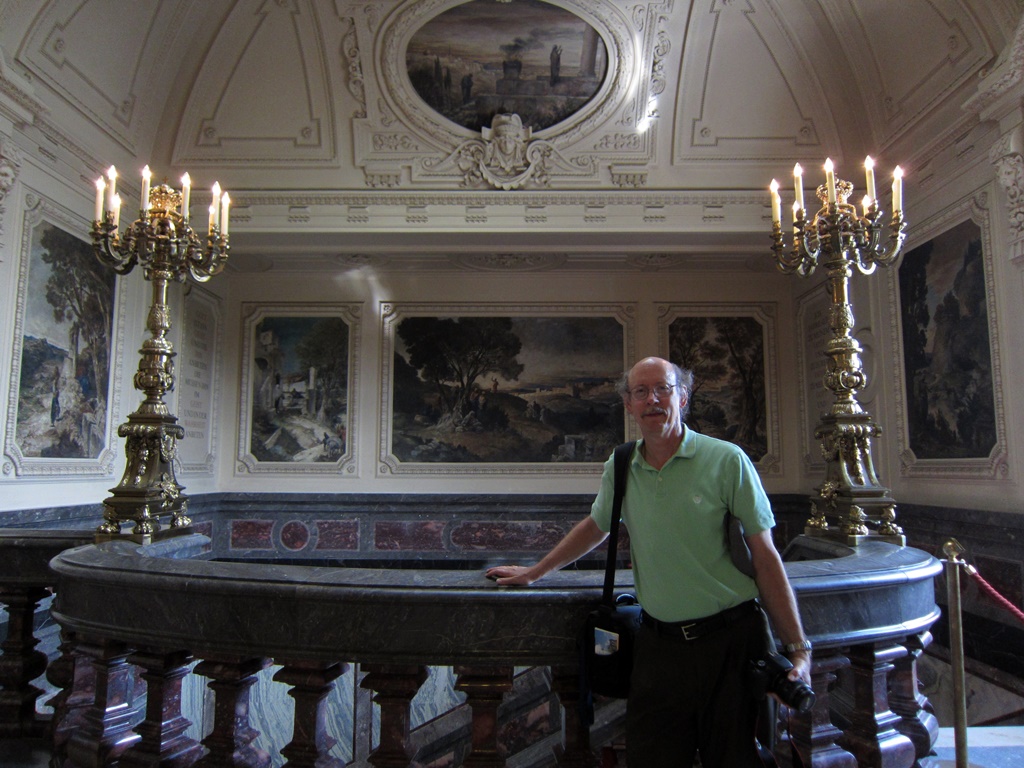
Bob at Top of Imperial Staircase
The museum had a number of artifacts, including 19th Century models of concepts for the new
church that was being considered at the time. Some of the models even had detailed interiors.
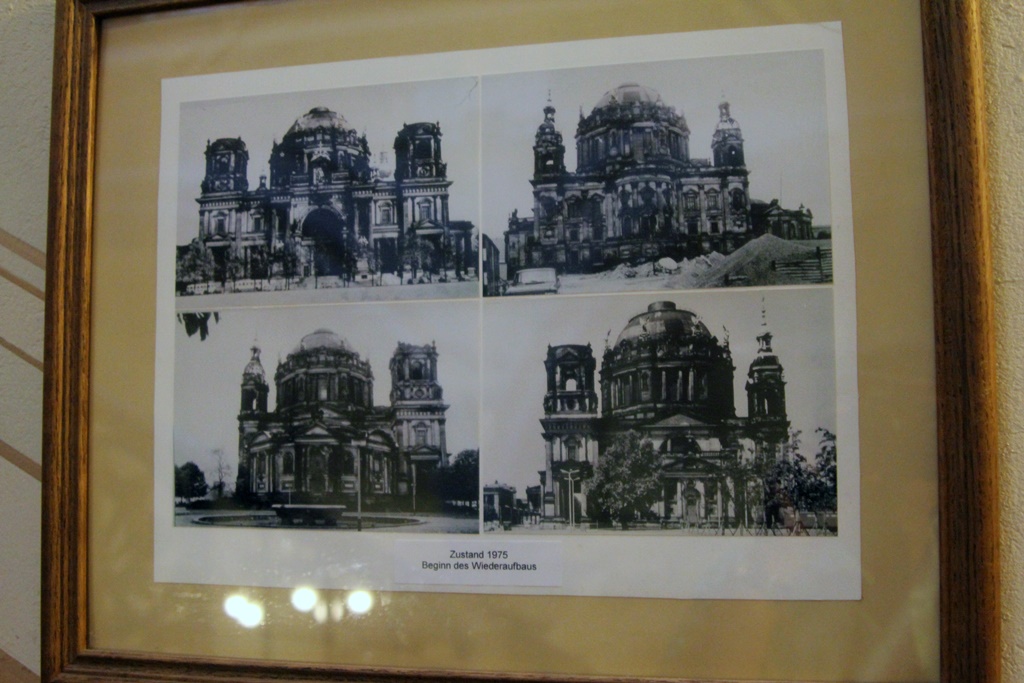
Pictures Prior to Reconstruction (1975)
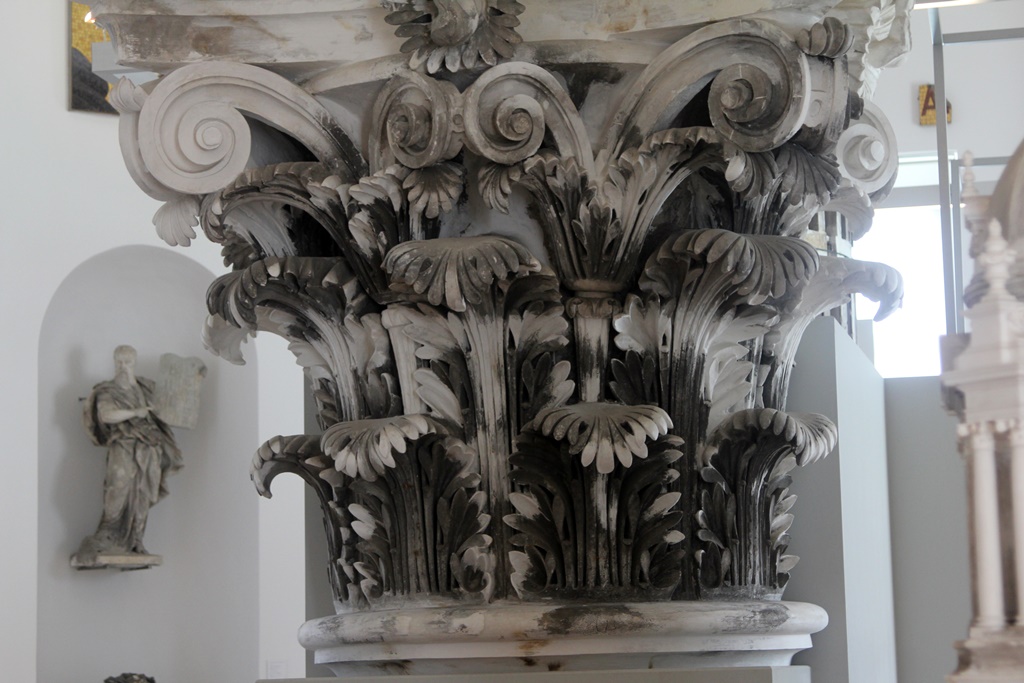
Model of a Capital for Exterior Columns
Model of a Basilica Design (1843)
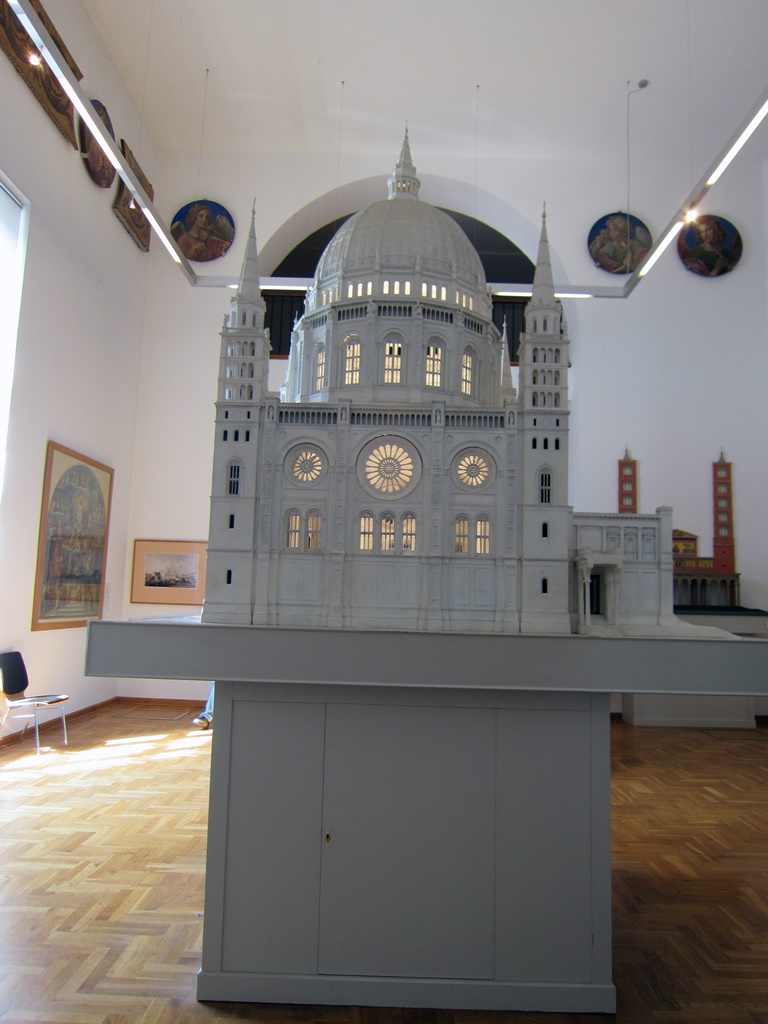
Model of Domed Cathedral
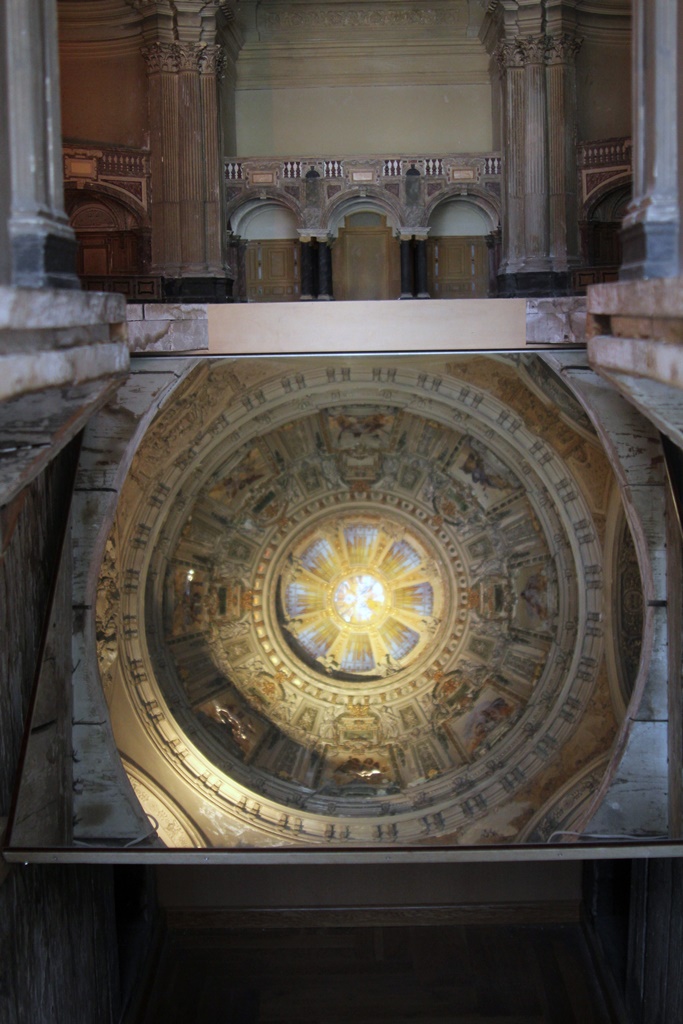
Domed Model Interior, Mirror View
From the museum, Connie and I continued upstairs to a walkway that circled
the outside of the dome. This walkway afforded us a terrific view of East
Berlin, in all directions. The points of interest we could see included:
- The Fernsehturm,
or television tower, built in the 60’s by the East Germans, and still the tallest
structure in Germany at 1207 feet
- The Rotes Rathaus, or red city hall, built in the 1860’s (and rebuilt in the
1950’s following war damage), still serving as Berlin’s town hall
- The Altes Stadthaus, or old city hall, opened in 1911 and rebuilt in the
1950’s and 1990’s, currently in use by the German Senate
- The St. Nikolai-Kirche (St. Nicholas’ Church), a reconstruction of Berlin’s
oldest church (the original was built between 1220 and 1230 and was largely
destroyed during the war)
- St. Hedwig’s Cathedral,
the largest Catholic church in Berlin, first opened in 1773, and also reconstructed following the war
- The Reichstag, the home of the German Parliament, visible in the distance
and discussed in more detail in a future page of this website
- The Die Welt (The World) balloon, a balloon named for a Berlin newspaper
and available for brief tethered ascents above Potsdamer Platz
- Unter den Linden ("under the lindens"), at one time the most famous and
grandest boulevard in Berlin (see the next web page)

Fernsehturm, Rotes Rathaus and Spree
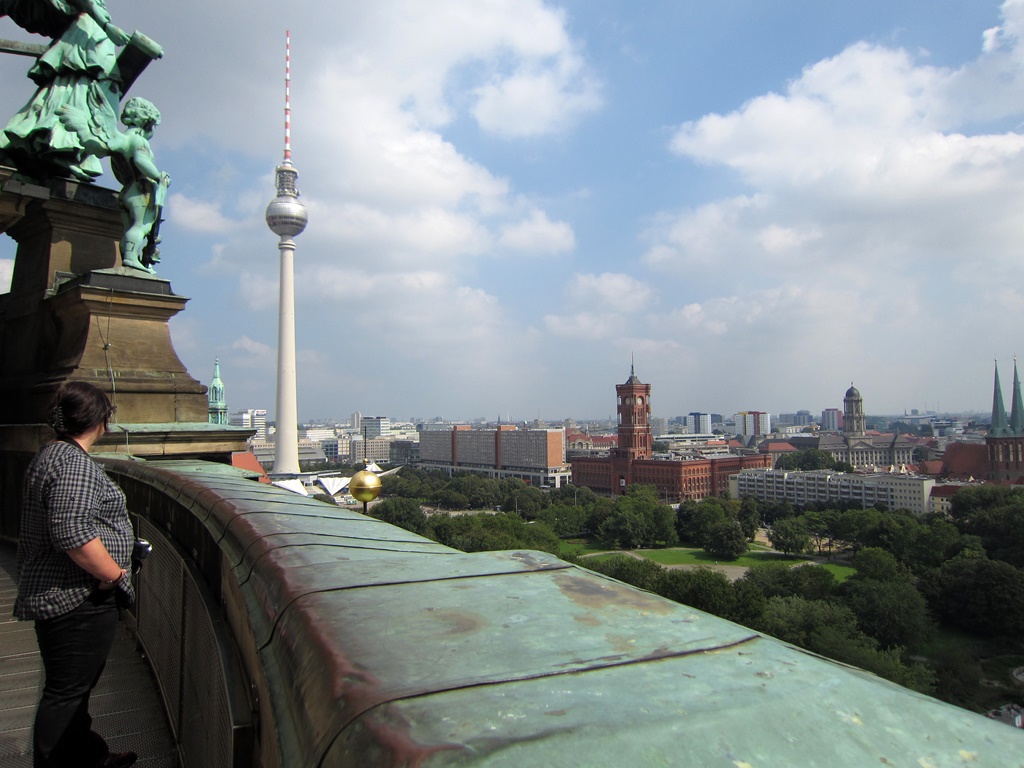
Walkway, Fernsehturm and Rotes Rathaus
Statues on Church
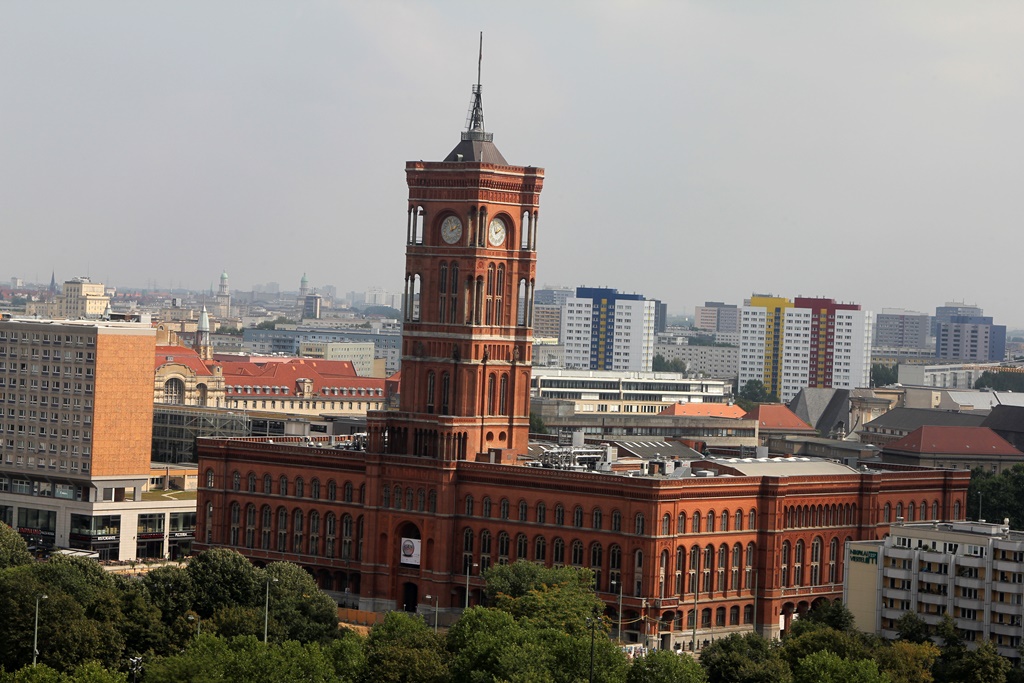
Rotes Rathaus
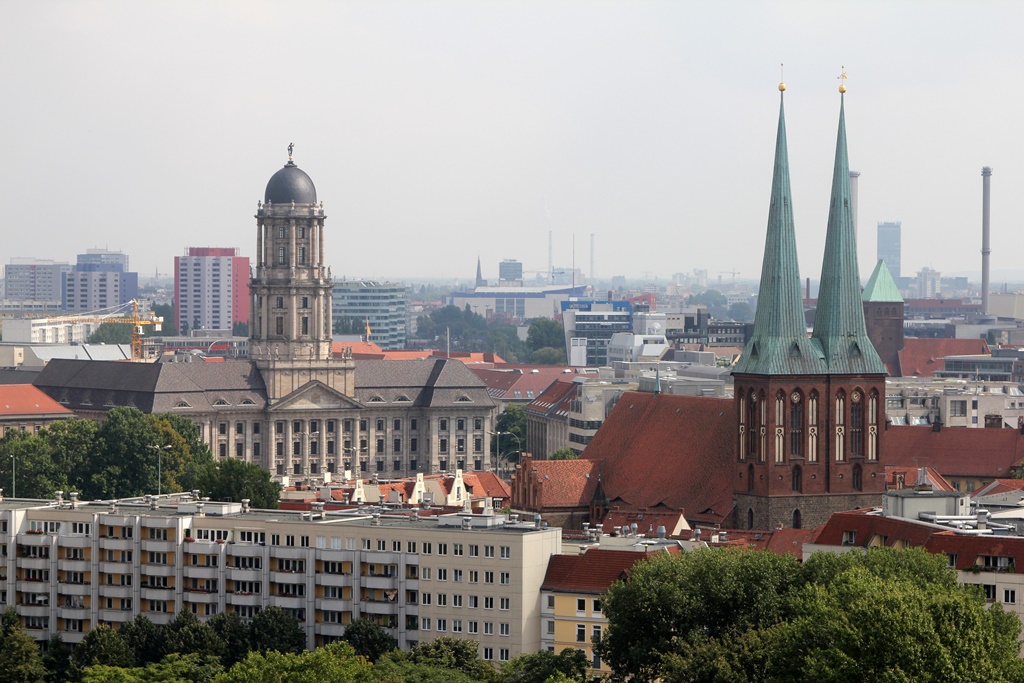
Altes Stadthaus and Nikolaikirche

St. Hedwig's Cathedral, Die Welt Balloon, Unter den Linden
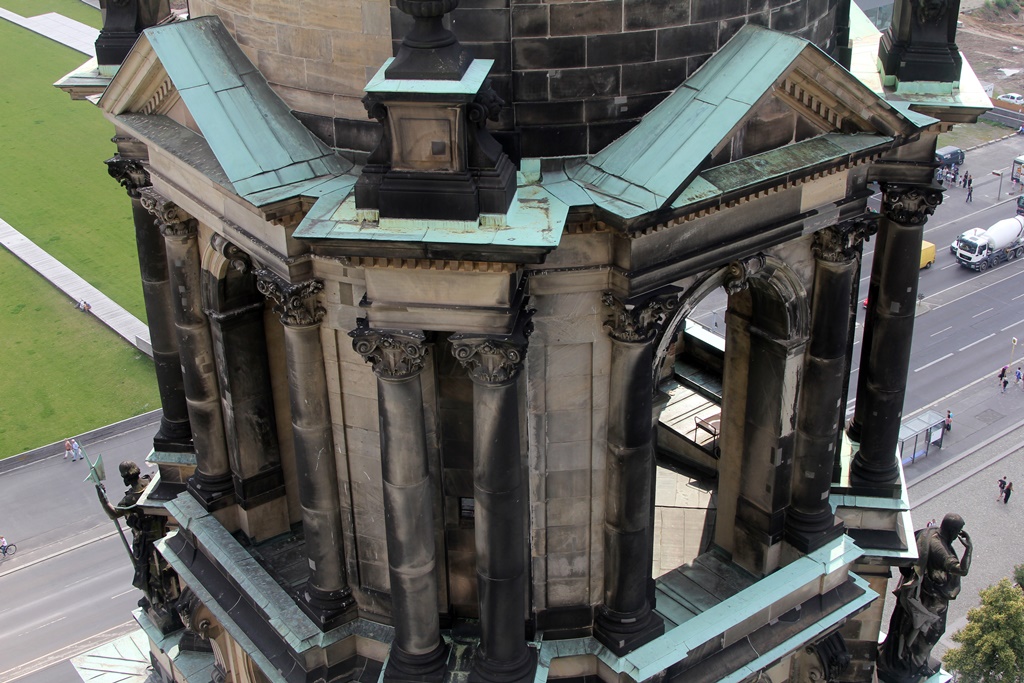
Church Detail
Also visible, naturally, were the museums of the Museumsinsel and the Lustgarten
in front of the church.
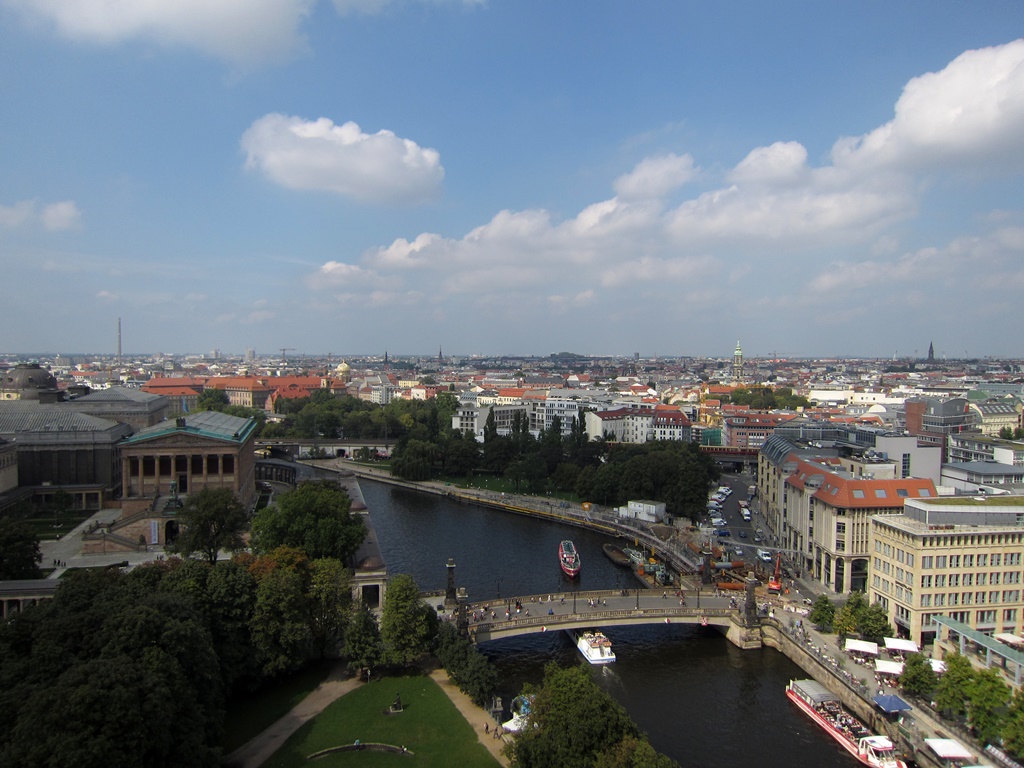
Spree River and Alte Nationalgalerie

Spree River, Alte Nationalgalerie and Trains
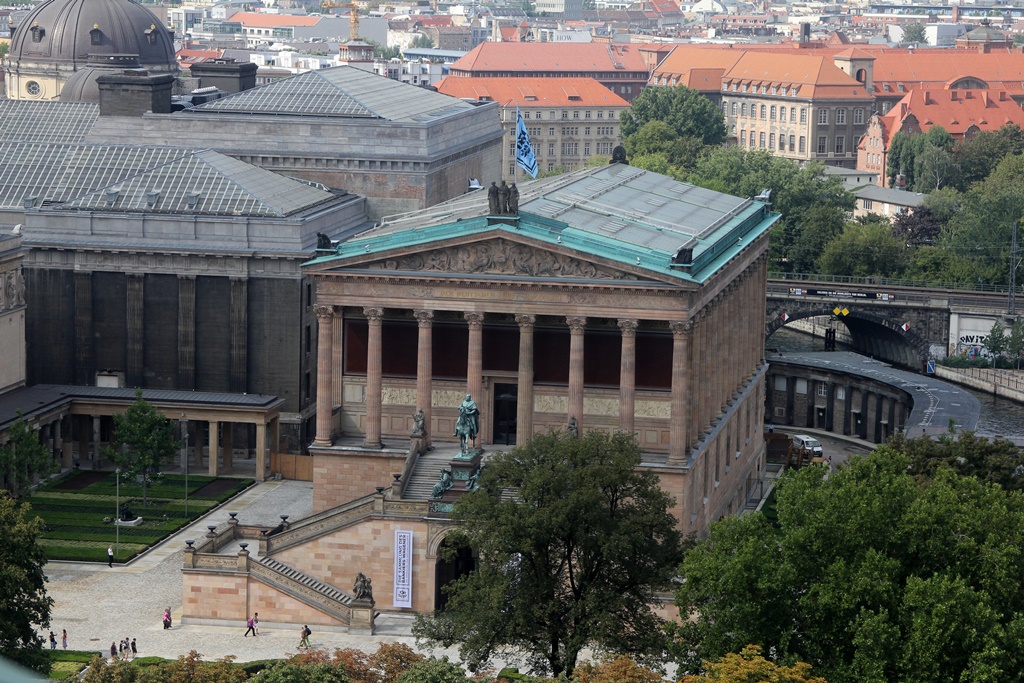
Alte Nationalgalerie
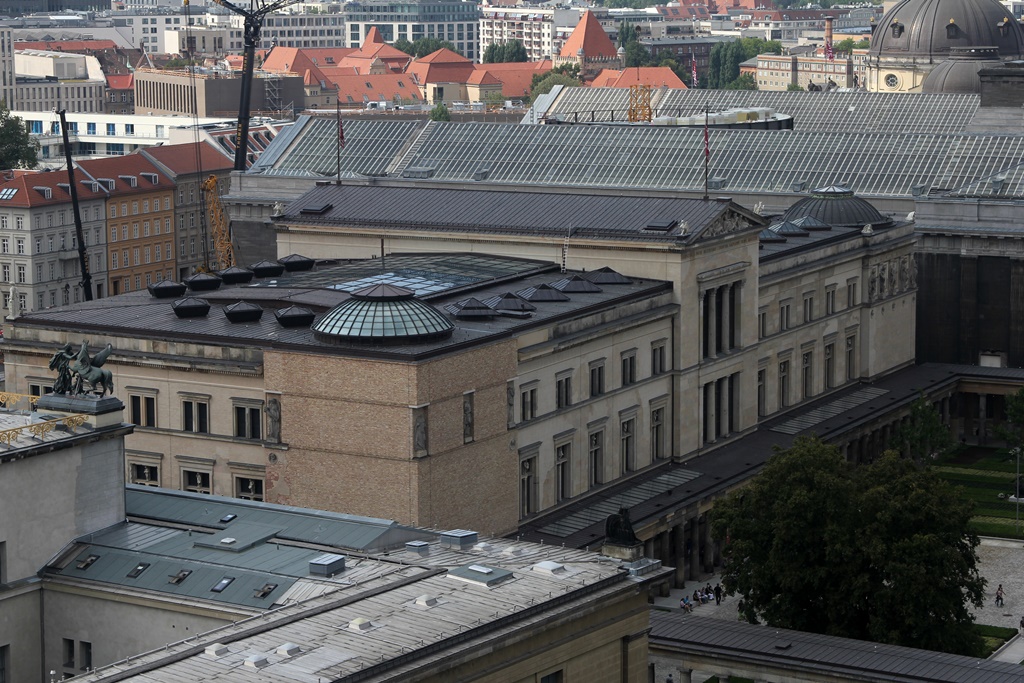
Neues Museum
Altes Museum

Cross, Lustgarten, Altes Museum and Reichstag
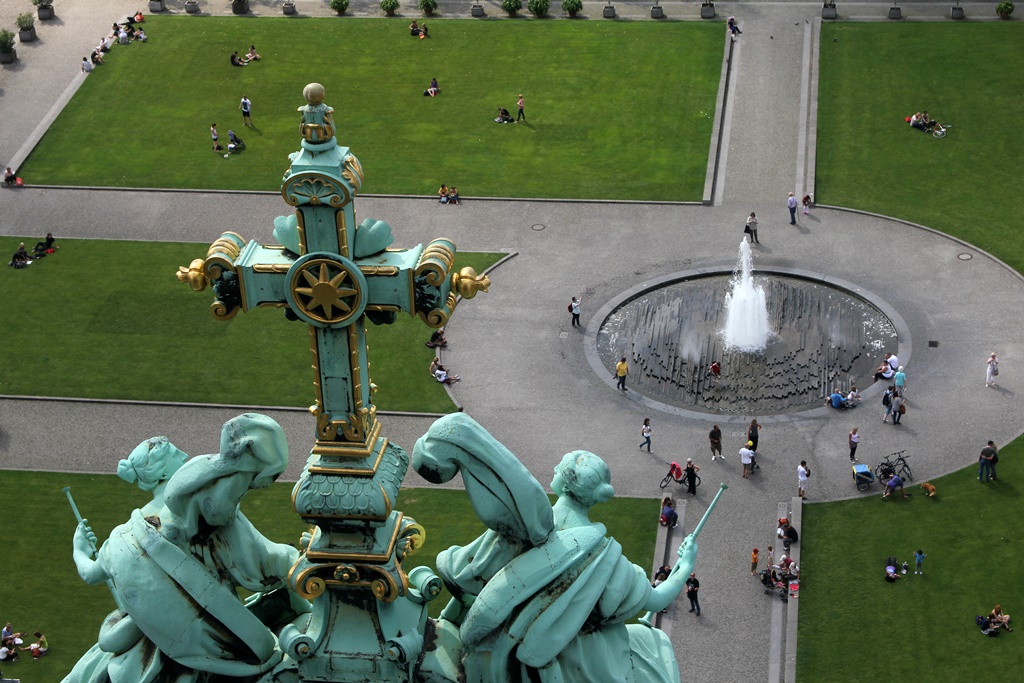
Cross and Lustgarten Fountain
On the way back down to collect Nella we briefly stopped in a balcony for
a bird’s-eye view of the interior.
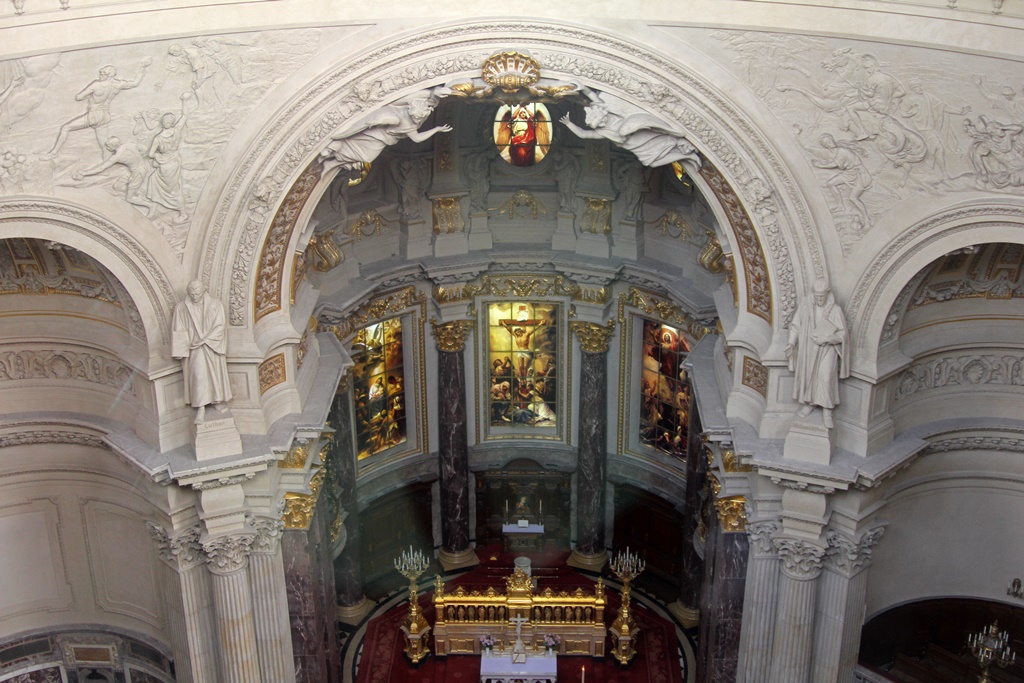
Apse
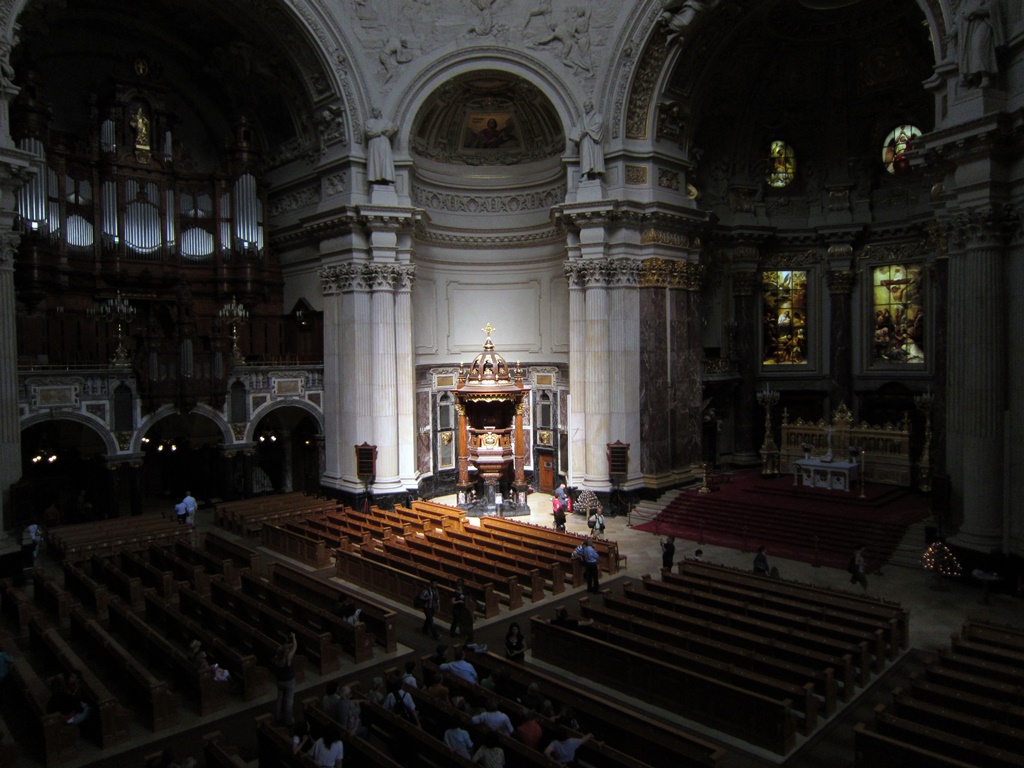
Inside the Berliner Dom
We departed the church and headed west, crossing the bridge over the Kupfergraben,
and started an exploration of Unter den Linden.

